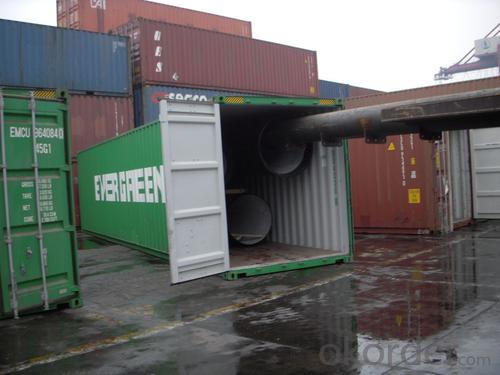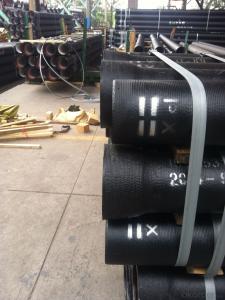DUCTILE IRON PIPES AND PIPE FITTINGS K8 CLASS DN1500
- Loading Port:
- Tianjin
- Payment Terms:
- TT OR LC
- Min Order Qty:
- 22 pc
- Supply Capability:
- 3000 pc/month
OKorder Service Pledge
OKorder Financial Service
You Might Also Like
Material : Ductile Cast Iron
Size Range : DN 80mm to DN 2000mm
Unit Effective Length : 6m or 5.7m
Manufacture Standard: ISO 2531:1998/ EN 545:2006/EN 598:2007
Annual capacity : 200,000 tons
Coating Exterior: Zinc 130g/m2 according to ISO 8179-1 and bitumen coating 70 microns.
Cement Interior: Portland Cement/ High Alumina Cement/ Sulphate Resisting Cement Lining according to ISO 4179
Special requirements on external coating and internal lining can be applied
We also provide accessories such as SBR/EPDM rubber gaskets, lubricant paste, pipe caps, PE sleeves, etc.
Additional Parts:
Each pipe is strictly inspected according to related standard to ensure permanently high performance.
Easy Installation at site and service free for life
Long Service Lifespan
Quotation will arrive you within 24hours once we get your inquiry.
We guarantee offering you a competitive price.
A copy of original inspection reports of pipes will be offered after shipment.
Photos of loading process will be sent to the customer after shipment effect.
We will follow-up the delivery progress after shipment effect and update to the customer on weekly basis.
- Q: What are the different methods for joining ductile iron pipe?
- There are several methods for joining ductile iron pipe, including mechanical joints, flanged joints, push-on joints, and restrained joints. Mechanical joints use a rubber gasket and a series of bolts and glands to create a secure connection. Flanged joints involve bolting two flanges together with a gasket in between. Push-on joints utilize a rubber gasket and require the pipe to be pushed into the joint. Restrained joints use a combination of mechanical joints and a restraining gland to prevent movement and provide a secure connection.
- Q: Can ductile iron pipe be used for horizontal directional drilling?
- Yes, ductile iron pipe can be used for horizontal directional drilling (HDD). HDD is a trenchless method of installing underground utilities, such as pipelines, without the need for traditional open-cut trenching methods. Ductile iron pipe is often used in HDD projects due to its strength, durability, and ability to withstand the stresses and strains associated with directional drilling. It has excellent resistance to external loads and can withstand the bending and pulling forces involved in HDD installations. However, it is important to consider factors such as pipe diameter, wall thickness, and soil conditions to ensure proper pipe selection for HDD projects. Additionally, proper installation techniques and precautions should be followed to ensure the long-term performance and integrity of the ductile iron pipe in HDD applications.
- Q: Are ductile iron pipes suitable for installation in areas with high soil compaction?
- Yes, ductile iron pipes are suitable for installation in areas with high soil compaction. Ductile iron pipes have high strength and durability, allowing them to withstand the pressure exerted by compacted soil. They can effectively resist external loads and provide long-term performance, making them a reliable choice for such areas.
- Q: Can ductile iron pipe be used in areas with high groundwater levels?
- Yes, ductile iron pipe can be used in areas with high groundwater levels. Ductile iron pipe is known for its durability and strength, making it suitable for use in various applications, including areas with high groundwater levels. Its corrosion resistance properties make it highly resistant to the corrosive effects of groundwater, ensuring long-term performance and reliability. Additionally, ductile iron pipe's joint flexibility allows it to withstand ground movement and settlement caused by fluctuating groundwater levels. Therefore, it is a suitable choice for areas with high groundwater levels, providing a reliable solution for water distribution systems and other underground applications.
- Q: How do ductile iron pipes handle ground settlement near construction foundations?
- Ductile iron pipes are known for their ability to handle ground settlement near construction foundations effectively. Due to their flexible nature, these pipes can withstand ground movement without experiencing severe damage or failure. When the ground settles near construction foundations, it can cause shifts in soil, which in turn can exert pressure on the surrounding infrastructure. Ductile iron pipes have the advantage of being able to absorb and distribute this pressure, minimizing the risk of pipe breakage or deformation. One key factor that contributes to the resilience of ductile iron pipes is their high tensile strength. This strength allows the pipes to maintain their structural integrity even under significant external forces. As a result, they can withstand ground settlement without experiencing fractures or cracks. Furthermore, ductile iron pipes also have a high degree of flexibility. This flexibility enables them to adapt to minor ground movements and accommodate shifts in soil without compromising their functionality. The pipes can bend slightly without breaking or causing leaks, ensuring continuous flow of fluids and preventing any disruptions to the construction project. In addition, ductile iron pipes are often installed with proper bedding and backfill materials. This ensures that the pipes have a stable and secure foundation, reducing the risk of movement and settlement. The use of these materials also helps distribute the load exerted on the pipes more evenly, further enhancing their ability to handle ground settlement. Overall, ductile iron pipes are an excellent choice for construction projects where ground settlement is a concern. Their strength, flexibility, and proper installation techniques allow them to effectively handle ground movement near construction foundations, providing reliable and long-lasting infrastructure.
- Q: What are the typical joint restraint requirements for ductile iron pipes in seismic zones?
- Ductile iron pipes in seismic zones require joint restraints to guarantee structural integrity and prevent displacement or separation during seismic events. These requirements are essential for maintaining the functionality and reliability of the pipeline system. In seismic zones, one common joint restraint requirement for ductile iron pipes is the utilization of flexible or mechanical joint systems. Flexible joints, like rubber gasket joints, are capable of absorbing and accommodating seismic movement. These joints allow for axial movement, angular deflection, and pipe expansion/contraction, thereby reducing the likelihood of pipe failure or damage. Another crucial requirement involves employing adequate anchoring systems to secure the pipes to surrounding structures or embed them in concrete thrust blocks. This prevents excessive movement or displacement during seismic events. Anchoring systems help distribute earthquake forces and minimize the risk of pipe separation or breakage. Moreover, seismic design standards often necessitate the use of seismic restraints, such as seismic joint restraints or bracing systems, to further enhance the stability and integrity of ductile iron pipes. These restraints restrict pipe movement in specific directions, thereby reducing potential damage and preserving overall system performance. It is important to acknowledge that specific joint restraint requirements for ductile iron pipes in seismic zones may vary based on local building codes, seismic activity levels, and engineering considerations. To ensure compliance with necessary seismic resistance requirements, it is crucial to consult relevant regulations and work with experienced professionals during the design and installation process.
- Q: How to analyze and judge the quality of ductile iron pipe
- On the quality of single pipe can analyze it from the surface is sand type and water cooled pipes, K8 pipe is different from Shanxi root nature is that the proportion of grade K9 cement and cast iron pipe and the K8 pipe are different, there is no national standard and non standard, no K8 tube, only is the production plant in order to obtain more profits, the dealer is not up to the national standard K9 grade pipe called K8 grade ductile pipe, K9 pipe cement weighs about 1/5 weight of the pipe, but is played in the role of anti-corrosion, the so-called K8 class water mud proportion some manufacturers terrifying 3/4 or 3/5, as the water supply pipe 3/5 or no personally think that two of the proportion of the tube is no problem
- Q: Can ductile iron pipe be used for stormwater systems?
- Ductile iron pipe is indeed suitable for stormwater systems. This material is widely utilized in various applications, including stormwater systems, due to its strength and durability. Its exceptional corrosion resistance makes it ideal for managing stormwater, which frequently contains debris and chemicals. Moreover, ductile iron pipe possesses impressive tensile strength, enabling it to withstand significant amounts of pressure and weight. Therefore, it is a dependable option for stormwater systems that may encounter substantial flow rates and occasional surges. Furthermore, ductile iron pipe is accessible in a variety of sizes and configurations, providing flexibility and adaptability when designing stormwater systems.
- Q: Can ductile iron pipes be used for underground hydropower systems?
- Yes, ductile iron pipes can be used for underground hydropower systems. Ductile iron pipes are known for their strength and durability, making them suitable for various applications, including underground installations. They have excellent resistance to corrosion and can withstand high pressure, making them ideal for carrying water in hydropower systems. Ductile iron pipes also have a long lifespan, reducing the need for frequent replacements and minimizing maintenance costs. Additionally, they have good joint integrity, ensuring leak-free connections underground. Therefore, ductile iron pipes are a reliable choice for underground hydropower systems.
- Q: Do ductile iron pipes require special maintenance?
- Indeed, special maintenance is necessary for ductile iron pipes. Despite their reputation for being strong and durable, ductile iron pipes are still vulnerable to specific types of corrosion. To prevent corrosion and extend the pipes' lifespan, regular maintenance is crucial. This maintenance typically involves conducting periodic inspections to identify any signs of corrosion or damage, as well as implementing cleaning and protective coating procedures. Furthermore, it is important to handle and install the pipes correctly to maintain their integrity. By regularly maintaining the pipes and adhering to industry best practices, one can prevent leaks, breaks, and other issues, ultimately saving valuable time and money in the long term.
Send your message to us
DUCTILE IRON PIPES AND PIPE FITTINGS K8 CLASS DN1500
- Loading Port:
- Tianjin
- Payment Terms:
- TT OR LC
- Min Order Qty:
- 22 pc
- Supply Capability:
- 3000 pc/month
OKorder Service Pledge
OKorder Financial Service
Similar products
Hot products
Hot Searches
Related keywords
























